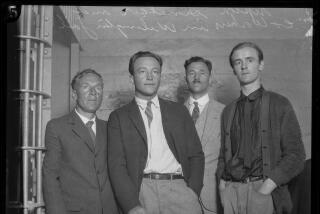Bernard Siegan, 81; Legal Scholar Fought for Economic Rights
Bernard Siegan had one guiding principle when it came to interpreting the U.S. Constitution: What did the founding fathers intend? His conclusions often put him at odds with mainstream legal thought.
The legal scholar and constitutional expert believed that 19th century Supreme Court justices were wrong to have allowed the printing of paper money, because the Constitution refers to only the minting of “gold and silver coin.”
He found the high court of the mid-20th century equally as vexing for striking down prayer in public schools. Siegan argued that the phrase “separation of church and state” appears nowhere in the Constitution.
An academic career spent floating often controversial ideas failed to prepare Siegan for the firestorm that surrounded his 1987 nomination to the 9th U.S. Circuit Court of Appeals in California.
Thrust into the national spotlight, he found it bruising as critics called him a “crank” and his ideas “eccentric.” Had he foreseen the negative reaction in Congress and in the press, the University of San Diego law professor later said, he would have turned down the appointment by President Reagan.
“At times, I felt like Public Enemy No. 1,” the soft-spoken Siegan told The Times in 1988 after the Senate Judiciary Committee denied his confirmation along party lines.
Siegan died Monday of complications related to a stroke at the Silverado Senior Living care facility in Encinitas, Calif., the University of San Diego announced. He was 81.
“This was an unlikely firebrand,” said Richard A. Epstein, a University of Chicago law professor. “What made Bernie such an important figure was that his legal instincts were very good.”
Siegan’s strongly held conviction -- that economic freedoms deserved the same protections as the freedoms of speech, religion and the press -- went “very much against conventional wisdom in the 1970s,” said Maimon Schwarzschild, a fellow law professor at the University of San Diego.
It also made Siegan, a Libertarian, one of the key legal and constitutional thinkers in the movement of ideas that became the Reagan Revolution, according to Schwarzschild.
“Bernie was one of the very early voices, a lonely one in the 1970s, developing this idea,” he said. “But he consistently and stalwartly wrote and spoke out for economic liberty under the Constitution.”
A 1980 book by Siegan, “Economic Liberties and the Constitution,” was “the opening salvo” in the revival of the property-rights movement, said Epstein, a legal scholar who has written about property rights.
“Through dint of hard work and historical curiosity, he converted practitioner’s wisdom into a fairly powerful book that became a basic point of reference for virtually every major scholar” on the subject, Epstein said.
That book, and another in 1987, “The Supreme Court’s Constitution,” argued that the high court had gone well beyond constitutional bounds and intruded on the rights of individuals and businesses to be left alone.
That view put Siegan in conflict with the Supreme Court, which since the New Deal era has allowed governments to regulate business in the interest of health, welfare or safety.
If Siegan’s thinking were applied to the bench, critics said, it would tear up half a century of government regulation.
Before voting on the 9th Circuit nomination, Sen. Edward M. Kennedy (D-Mass.), who was chairman of the judiciary committee, called Siegan’s views “far, far outside the mainstream.”
Some Democrats cited Siegan’s lack of federal court experience in voting against him, while Republicans denounced the action as politics as usual.
“Bernie would have been an excellent federal court justice,” Epstein said. “He was so scrupulous. He would never make a generalization unless he knew the particulars.”
The son of Russian-Polish immigrants, Bernard Herbert Siegan was born July 28, 1924, in Chicago. He spoke only Yiddish until he was 5.
After attending junior college and serving in the Army during World War II, he earned a law degree in 1949 from the University of Chicago.
Three years later, he began working as a land-use attorney and real estate developer in Chicago. Wanting to become an academic, Siegan in 1973 closed his real estate law practice in Chicago after 20 years to join the faculty at the University of San Diego, with which he remained affiliated until his death.
Known to be engaging and charming, Siegan was considered good company by university colleagues who often hoped to be invited to his La Jolla home, which overlooked the Pacific and was once owned by mystery novelist Raymond Chandler.
Siegan’s wife of 32 years, Sharon, died in 1985.
Survivors include his second wife, Shelley, whom he married in 1995, and a stepson, Jon Zifferblatt.
More to Read
Sign up for Essential California
The most important California stories and recommendations in your inbox every morning.
You may occasionally receive promotional content from the Los Angeles Times.











